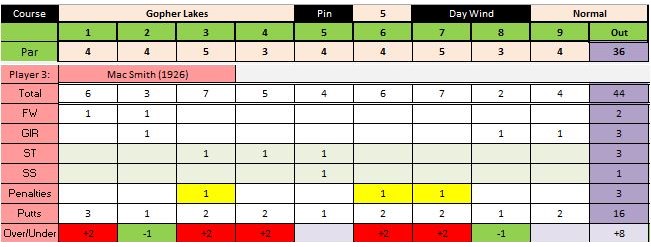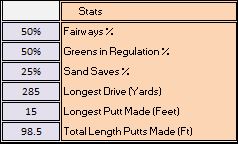It had all the makings of an historically bad round, yet wasn’t. But it wasn’t pretty either–unless you mean pretty wild. Today’s round with Macdonald “Mac” Smith (1926) at Gopher Lakes was one of the most unusual I’ve ever played.
It happened in the third round of my All-Time Greats (ATG) tournament. Smith began the day at even par after shooting a 70 at Yatch Club (par 71) and a 73 at Badger Links (par 72) in the previous two rounds.
Smith’s day got off to a bad start on the first tee with a double-bogey six after 3-putting from 32 feet despite playing it safe. He lagged the putt up there nicely to within two feet, but then missed the easy short putt. For a moment, it looked like this might have just been a case of early morning jitters, as Mac birdied the next hole by draining a 15-footer that had a 25% Make Probability for him.
But things got uglier after that. He double-bogeyed four out of the next five holes, thanks, in part, to three penalty strokes. Two of these shots found the water and another was the result of an unplayable lie in a green-side bunker. When it rains, it pours.
By sinking a 12-footer, Smith managed to birdie dangerous No. 8, a 176-yard par 3 with lake water in front and to the right of the green. With two birdies and five double-bogeys, Mac made the turn at 8 over. It looked like this was going to be “one for the ages” and not in a good way.
Here’s his scorecard for the front nine. Red=double-bogey, Green=birdie, Yellow=penalty stroke.

Meanwhile, Smith’s playing partners, Mike Souchak (1959) and Craig Wood (1941), finished the front nine at 1 under and even par, respectively. Souchak would go on to have his troubles on No. 12, where he 4-putted from a distance of 29 feet. (In fairness to him, this nasty par 4 requires that ALL putts be read 2 columns longer than the actual distance.) Wood managed to (mostly) avoid problems until his tee shot on par 3 No. 17 bounced LEFT into the pond. Both Souchak and Wood finished 2 over for the day with 74’s.
Things turned around some for Smith on the back nine. He birdied Nos. 10, 15, and 16 but still bogeyed 13 and 14, in part, because of his inability to avoid trees and sand. He finished the day with a 79 (+7), piling up a total of five double-bogeys and an equal number of birdies. In doing so, he dropped to a tie for 67th place with Craig Stadler (1982)–two strokes ahead of Billy Burke (1931) at 9 over in dead last.
Here’s Smith’s scorecard for the back nine:

On the day, Smith’s stats aren’t all that remarkable except for the three penalty strokes. I’ve only logged 15 rounds so far on Gopher Lakes with the ATG golfers, but Smith’s other numbers (as shown below) don’t look that much different from the rest of the field on average. Of course, since this is Round 3 of tournament play, the better golfers have yet to tee off.

I have had my share of good rounds and bad ones playing the APBA Golf Master Game. But this particular round was one of the more unusual ones, especially for a Calm day with Normal course conditions.
Gopher Lakes is turning out to be one of the more challenging courses I’ve played so far. Some of that is due to its incredible length: 7677 yards. But even the bombers don’t have a big advantage because of the number of doglegs and strategically-placed fairway bunkers.
The rest of this round should be quite an adventure! I’ll keep you posted. If you have an interesting round or APBA golf story you would like to share with others, please let me know. I’d be happy to have you post it on this site.
While I have had this course for a while, I final got around to playing it. To start this post, let me say that I am not a fan of Gopher Lakes. My first take is that its layout is not too difficult (except for a few holes which are really hard), but because of all the many green instructions, as well as plenty of other shot instructions, that complicate and slow down play. I will assume the designer provided the instructions to add as much realism as possible. That realism can come at the cost of playability, however.
When it comes to difficulty, Scott makes mention of two holes that earn special recognition:
• No. 12 is just penal. It is uphill and well over 500 yards with water 10 yards off the CL short and right of the green. It also has the most penal green instruction of any I’ve seen in that it directs all putts be read 2 columns longer. I played this hole into the wind. Not fun.
• The 248-yard Par 3 that comes up next is no pleasure either. The hole features water 20-yards left of the green’s CL with an instruction that directs balls landing in the rough left of the green (which extends 10 yards left from the CL) go left five more yards. Thus shots 15 yards left of the CL that carry to the front of the green will almost certainly end in the drink.
While Gopher Lakes’ greens are normal size, the designer decided to stick the majority of pins on every hole less than a full square from the edge. Pin spot No. 2, the one the dice roller chose for me, has all of its positions less than one full square from the edge of a green. Finally, woe to those on the wrong side of a green’s red line, which show up on the 5 greens or on the wrong side of a pin that apply to a few more. Finally, when playing Pin 4, instructions make it possible to putt off the green into the water on Hole 10. Though it didn’t happen on this round, I wonder how the Game Caddie would account for that result.